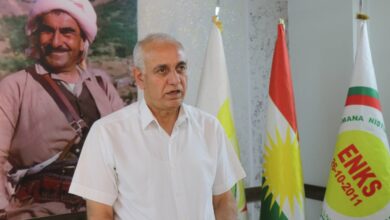Syria: Chemicals Used in Idlib Attacks
(New York) – Evidence strongly suggests that Syriangovernment forces used toxic chemicals in several barrel bomb attacks in Idlib governorate between March 16 and 31, 2015. Syrian rescue workers reported that these attacks affected at least 206 people, including 20 civil defense workers. One attack killed six civilians, including three children. The attacks violated the Chemical Weapons Convention and a United Nations Security Council resolution.
Human Rights Watch conducted inquiries into six attacks in which Syrian government helicopters dropped barrel bombs containing gas canisters that local residents reported contained chemicals. In three of these attacks, witness accounts and photo and video evidence strongly indicated a chemical attack; three other incidents require follow-up inquiries. While Human Rights Watch cannot conclusively establish the chemical used, several witnesses described a chlorine smell. Syrian government forces have previously dropped barrel bombs embedded with cylinders of chlorine gas.
“Syrian authorities appear once again to have shown complete disregard for human suffering by violating the global prohibition against chemical warfare,” saidNadim Houry, deputy Middle East and North Africa director. “The UN Security Council and countries that are members of the Chemical Weapons Convention need to respond strongly.”
Syrian Civil Defence volunteers, a group of rescue workers operating in areas outside the control of the government, documented 14 barrel bombs that contained apparently toxic chemicals. They reported that they were used in seven attacks in four locations in Idlib governorate between March 16 and 31. Local activists and journalists reported additional similar attacks.
In three attacks examined by Human Rights Watch, people near the impact sites exhibited symptoms consistent with exposure to toxic chemicals, and gas canisters were among the barrel bomb remnants at the impact sites, Human Rights Watch said. Witnesses described a strong chlorine smell at the impact sites or from the clothes of those affected.
All the attacks took place in territory controlled by armed opposition groups and in the context of fighting for control of the city of Idlib. On March 18, the Islamist group Jabhat al-Nusra and other armed opposition groups opened a major offensive against government forces in the city that culminated in its capture on March 28.
Two witnesses near the targeted areas in two of the incidents said they heard helicopters shortly before the attacks. First responders saw and filmed remnants of barrel bombs, which can only be delivered by aircraft. Only government forces are known to use barrel bombs in Syria.
Among the remnants, witnesses reported finding containers typically used for refrigerants in refrigerators and air-conditioners. Videos and photos from the aftermath of five attacks, including material shared by the Syrian Civil Defence, show containers of a size, shape, and design commonly used for refrigerants. These canisters are easy to refill with other gases and widely available in Syria.
Three doctors who treated those exposed in two of the attacks told Human Rights Watch that symptoms included trouble breathing, burning eyes, burning sensation in the throat, and coughing. In the most serious cases, the doctors described patients suffering from pulmonary edema, or fluid in the lungs. Keith Ward, an independent expert on the detection and effects of chemical warfare agents, reviewed the clinical signs and symptoms described to Human Rights Watch and the videos of victims from two of the attacks and said they were consistent with exposure to a choking agent.
It was not possible to conclusively determine what toxic chemicals were used, Human Rights Watch said. The chlorine smell reported by rescue workers and doctors, a local journalist’s report of a yellow gas leaking from a refrigerant canister after an attack on Idlib city, and the Syrian government’s previous use of chlorine, suggest this chemical. Some symptoms of the victims are also consistent with acute exposure to refrigerants or to toxic gases that can result from the combustion of such refrigerants, but exposure to refrigerants alone would not account for the smell of chlorine.
Witness accounts, photos, and videos also indicate that barrel bombs in at least five attacks contained bottles with a red liquid, which Human Rights Watch has not been able to identify. It is unknown what role, if any, this red liquid may have played in the attacks or their medical consequences.
The Chemical Weapons Convention, which Syria ratified in October 2013, bans attacks that use an industrial chemical as a weapon. Among other obligations, each member country agrees never to “assist, encourage or induce, in any way, anyone to engage in any activity prohibited to a State Party under this Convention.”
On March 6, 2015, the UN Security Council adopted Resolution 2209 in which it expressed concern that toxic chemicals had been used as a weapon in Syria and decided that in the event of non-compliance, it would impose measures under Chapter VII of the UN Charter.
The Security Council, which discussed reports of toxic attacks in Syria on April 2, should take decisive action to stop the use of toxic chemicals as a method of warfare, including by establishing responsibility for the attacks and imposing an arms embargo on parties using such weapons, Human Rights Watch said.
The Security Council should direct all parties to the conflict in Syria to grant the Organization for the Prohibition of Chemical Weapons (OPCW) access and provide for the mission’s safety and security in areas under their jurisdiction or control. On March 25, the OPCW director general stated that they are monitoring “the recent reports suggesting that toxic chemicals may have been used as weapons in the Idlib province” of Syria.
“The Syrian government appears to be thumbing its nose at the Security Council and international law yet again,” Houry said. “The Security Council shouldn’t delay getting to the bottom of this recurring use of chemical weapons and press the government to stop.”
More Details About the Idlib Attacks
Human Rights Watch conducted inquiries into the following barrel bomb attacks in Idlib governorate that raised concerns of toxic chemical use:
- March 16, around 8:30 p.m., Qmenas
- March 16, around 10-11 p.m., Sarmin, 6 civilians killed
- March 23, 2:30 a.m., Sarmin/Qmenas
- March 24, Binnish
- March 26, around 2 a.m., Sarmin
- March 31, 2 p.m., Idlib city
Of these attacks, Human Rights Watch gathered the most conclusive information about the three attacks on March 16 and 31.
Sarmin and Qmenas, March 16
Barrel bombs appearing to contain chemicals were used in attacks on Sarmin, a town 10 kilometers southeast of Idlib city, and Qmenas, a small village 3 kilometers from Sarmin, on March 16. The attacks killed six civilians and affected at least 110 with various symptoms. Human Rights Watch determined that chemicals were used from interviews with two local rescuers, an activist who assisted in the rescue, two doctors who treated those affected, and an examination of photos and video footage.
In the evening of March 16, two Sarmin residents said they heard a helicopter. “We prepared to react to two attacks,” Leith Fares, a rescue worker with Syrian Civil Defence, told Human Rights Watch. “A helicopter always drops two barrels.”
The witnesses in Sarmin reported hearing no explosions. “You know, we were at first actually happy,” Fares said. “It is usually good news when there is no explosion.” Ten to 15 minutes after hearing the helicopter however, wounded began arriving at the field hospital in Sarmin, a local doctor said.
Two barrel bombs had been dropped on nearby Qmenas. Local residents are confident that it was the same helicopter overheard in Sarmin that dropped these barrel bombs as they heard no other aircraft around that time.
Muhammad Yazan, a local activist who went to the impact site, told Human Rights Watch that the barrels had struck farming fields outside Qmenas. About 30 civilians and 40 opposition fighters in the area became sick shortly after the attack and sought treatment at the hospital, according to a rescue worker.
Later that evening, a helicopter dropped two barrel bombs on southeast Sarmin. One struck a two-story house. Fares, the rescue worker, said he went to the site immediately: “The destruction was only from the impact of the barrel. There had been no explosion at this site either.”
Two rescue workers and an activist who were at the impact site shortly after the attacks to evacuate people told Human Rights Watch that they smelled chlorine at the attack sites. Two doctors who treated those affected by the attacks reported smelling chlorine on the victims’ clothes.
Yazan, who went to both the Qmenas and Sarmin impact sites immediately after the attacks on March 16, described the impact site near Qmenas: “There was a very strong chlorine smell there. One of our team members passed out due to the smell. It was horrible. My eyes were burning, I wanted to throw up. My skin felt like I had rashes.”
Mohamed Ghaleb Tirani, the director of the field hospital in Sarmin who treated many of those affected by the attacks, told Human Rights Watch that the patients’ clothes smelled strongly of chlorine – “like the detergent.” Mohamed al-Tamer, a doctor in Saraqeb, a neighboring town, told Human Rights Watch that he treated patients from the attacks and that he also smelled chlorine on their clothes.
Fares said that the Syria Civil Defence team had learned that a family was trapped in the basement of the house hit by one of the barrel bombs in Sarmin. He said he went down to the basement of the Talib family house:
We arrived there seven minutes after the strike. We had no protective equipment. Still, we went down to the basement three by three. I felt short of breath, coughed and became dizzy. I couldn’t even take two breaths. I could not bear more than 40 seconds downstairs.
Syrian Civil Defence rescue workers found six members of the Talib family in the basement, including three children ages 1, 2, and 3. “They looked dead, but they had no visible wounds,” Fares said. Dr. Tirani, who received them at the hospital, told Human Rights Watch:
Aioush [Talib, the grandmother], 65, died before arriving at the hospital. We tried to treat the others. The children were foaming at the mouth, they were suffocating, then their hearts stopped. The parents had trouble breathing. We tried to treat them, but they died as well.
Human Rights Watch reviewed disturbing video footage of doctors unsuccessfully trying to resuscitate the three children. The children in the footage have no signs of physical wounds. Tirani said that four of the paramedics at the hospital were affected by second-hand exposure, including burning eyes and shortness of breath and dizziness.
Rescue workers and activists who examined both the Qmenas and Sarmin impact sites the next day told Human Rights Watch that at each site they found barrel bomb remnants, including several gas canisters normally used for storing refrigerants for refrigerators and air conditioners. One rescue worker told Human Rights Watch that he saw yellow residue on one of the canisters at the Qmenas impact site. Fares sent Human Rights Watch a photo that he took at one of the sites showing what appear to be deformed gas canisters. A video that the Sarmin Coordination Council posted on March 17 shows remnants of the barrel bomb and several erupted refrigerant gas canisters.
Fares and Yazan each told Human Rights Watch that they saw a red liquid at the attack sites. Faras said that he found 12 bottles that had contained a red liquid at the Talib family house. “Some were burned, some empty, and some still filled with the red liquid,” he said. Fares sent Human Rights Watch two photos that he took by the Talib family house showing remnants of the bottles with the red liquid. Human Rights Watch has not been able to identify the red liquid or its function.
Tirani told Human Rights Watch that the hospital treated about 110 people with various symptoms in the evening on March 16: 70 people after the first attack, 20 after the second, and 20 rescue and medical workers, some of whom were affected by second-hand exposure.
Tirani said that those with mild symptoms were coughing, had trouble breathing, and suffered burning eyes and a burning sensation in the throat. Moderate symptoms included hallucinations, vomiting, and foaming at the mouth. People with the most serious cases suffered from pulmonary edema, or fluid in the lungs. A doctor in Saraqeb, about 10 kilometers from Sarmin, who also treated people affected in the two attacks, described similar symptoms.
Human Rights Watch reviewed five videos that the Sarmin Coordination Council, the Syrian Civil Defence, and the Smart News Agency, a local news agency, posted on YouTube showing victims with symptoms consistent with exposure to chemicals.
Farmlands near Sarmin and Qmenas, March 23
Syrian Civil Defence reported that barrel bombs appearing to contain chemicals struck Sarmin and Qmenas on March 23, affecting at least 20 people.
Yazan, the local activist from Sarmin, who had gone to the attack site, told Human Rights Watch that the attack took place around 2 a.m. and that 12 people were affected by gas. Because the barrel bombs fell in fields, they were only found the following day. Yazan said that they found the same type of refrigerant canisters at these sites and soil that had been colored red. He said he could detect a faint smell of chlorine.
Three videos posted by the Sarmin Local Coordination Council show interviews with people who allegedly live close to the attack site. In two of the videos, the witnesses described the smell of chlorine or “a strong odor” (videos 1, 2 and 3). Human Rights Watch was not able to independently confirm the attack or determine the number of civilians affected.
A video from the impact site filmed by Syrian Civil Defence shows remnants of a barrel bomb, several refrigerant canisters, and what appear to be remnants of several bottles like those found at other sites containing red liquid.Another video, also allegedly from the aftermath of the same attack, shows a close-up of a refrigerant canister.
Sarmin, March 26
Syrian Civil Defence reported that barrel bombs appearing to contain chemicals struck the western edge of Sarmin on the night of March 26, affecting about 10 people. Mouti` Jalal, a rescue worker with Syrian Civil Defence, told Human Rights Watch that the people affected were coughing and had teary, red eyes. Jalal said that they found several refrigerant canisters at the site.
A video that Syrian Civil Defense said was from the aftermath of the attack shows rescue workers carrying a coughing man into a medical facility. Another video shows first responders accompanying two children to the same medical facility.
Binnish, March 24
Barrel bombs allegedly containing chemicals struck Binnish, a town about 10 kilometers northeast of Idlib on March 24, two rescue workers told Human Rights Watch. One said that a barrel bomb appearing to contain chemicals struck the town on March 19 as well, but Human Rights Watch was not able to independently corroborate this claim.
Mouti` Jalal, the rescue worker, who said he visited the site soon after the attack, said that two barrel bombs struck the eastern part of Binnish on the evening of March 24. He said that one bomb did not disintegrate on impact and that first responders buried it intact, fearing the chemicals they believed it contained. Jalal said that he detected the same chlorine smell near this impact site as he did by the March 16 Sarmin impact site. He said he assisted three people who were coughing after the attack.
Syrian Civil Defence provided several photos that they said their volunteers had taken in Binnish the day after the strike, showing remnants including several refrigerant canisters and a bottle of red liquid. Some canisters appear intact in the photos while others were dented. Mahmoud Ahmad Mohayar, a rescue worker from Binnish, confirmed that the Syrian Civil Defence photos were from Binnish and that he recognized himself in one of the photos. He told Human Rights Watch that the gas appeared to have discolored the wheat growing in the area, making it more yellow and orange.
A video posted on YouTube on March 24, said to be in Binnish, shows men, some with face masks, carrying people in civilian clothes who appear unconscious and several people, including young children, receiving what appears to be oxygen.
Idlib City, March 31
Barrel bombs apparently containing chemicals struck Idlib city on March 31. Human Rights Watch reached this conclusion based on interviews with local rescue workers, a journalist who visited the impact sites, and footage posted in the aftermath.
At about 2 p.m. on March 31, Syrian forces dropped at least two barrel bombs on Idlib. One struck the street in front of the Palace of Justice. Fares, the rescue worker who responded to the Sarmin attack, said that they were also working in Idlib because there were no Syrian Civil Defense teams there at the time. They arrived at the scene five minutes after the strike, he said:
It was the same smell as the one we smelled when I went to rescue the Talib family in Sarmin, just less intense because it was in the street and not in the basement. We also saw the same remnants: refrigerant gas canisters and bottles filled with red liquid.
Jalal, a second rescue worker who responded to the attack, said that he smelled chlorine near the site, the same as in the March 16 and 26 Sarmin attacks and the March 24 Binnish attack.
Muslim Sayed Essa, a journalist working for Orient News, a Syrian opposition media outlet, who also arrived at the scene shortly after the impact, told Human Rights Watch that he saw several gas canisters there and that a yellow gas was still leaking from one of them when he arrived.
A video posted on April 1 shows the remnants of the barrel bombs and gas canisters outside the Palace of Justice. In another video, a rescue worker is holding up what appears to be bottles filled with red liquid similar to those in the Sarmin and Binnish attacks. The rescue worker points to soil in the impact crater that appears to have been colored red. In a third video, the same rescue worker points to a pool of red liquid on the asphalt, saying that water on the ground turned red from the attack. In a fourth video, several remnants of the bottles are visible.
One video allegedly from the aftermath of the attack, which Smart News Agency, a local news agency, posted on April 1, shows rescue workers washing three men who appear to have difficulty breathing.
Witnesses also reported that barrel bombs with apparent toxic chemicals struck near the al-Mehrab roundabout, the Maarat Misrin roundabout, and near the stadium at about the same time. Ali Aboud, who works for a humanitarian organization of the Orient group – the same group that owns the Orient’s news outlet – told Human Rights Watch that he was between the al-Mehrab and Maarat Misrin roundabouts when the strikes occurred:
People were fleeing from both places and we were stuck in the middle. Cars were going in all directions, people were running. We saw yellow smoke from both places. My eyes started burning, it felt like something was blocking my throat. Eventually we escaped through some of the smaller roads.
A doctor from the Binnish hospital told Human Rights Watch that he also observed the strikes on the Maarat Misrin roundabout in Idlib and another strike “400 meters east of the roundabout,” which might refer to the strike on the al-Mehrab roundabout:
People were very afraid, saying that they were dying. They had difficulty breathing, and two children had red eyes and face. One person was vomiting a lot. We took them to the Binnish hospital where we washed them and gave them oxygen.
Witnesses also described several other barrel bomb attacks in Idlib at the time, but Human Rights Watch was not able to corroborate those attacks independently. On the morning of March 30, Syrian Civil Defence reportedthat four barrel bombs believed to contain toxic chemicals struck the al-Mehrab roundabout and the al-Matahen area. The report included a photo from the site.
Essa, the Orient News journalist, and his brother Fouad told Human Rights Watch that they had seen attacks that apparently used toxic chemicals on March 23 in the fields outside Idlib, and on March 25 near the Idlib central prison. They said that they also saw refrigerant gas canisters at these sites and that they experienced difficulty breathing and burning eyes. They said they did not film or take photos because it was dark. Foud said that the smell was like that from “cleaning products.”
Past Chemical Attacks
Human Rights Watch concluded that the evidence strongly suggested that Syrian government authorities usedthe nerve agent Sarin in attacks on two Damascus suburbs on August 21, 2013, and chlorine as a weapon in attacks on three towns in northern Syria in April 2014. The Security Council condemned both uses without specifying the responsible party.
In September 2014, a fact-finding mission appointed by the Organization for the Prohibition of Chemical Weapons (OPCW) found “with a high degree of confidence, that chlorine was used as a weapon systematically and repeatedly in three villages in northern Syria.”
While the OPCW fact-finding mission did not have a mandate to identify those responsible, a Human Rights Watch investigation into the April 2014 attacks found evidence that strongly suggested that the chlorine gas cylinders were contained in barrel bombs dropped by government helicopters.
The Syrian government in 2014 accused opposition armed groups of using chlorine. On November 30, Faysal Mekdad, Syria’s deputy foreign minister, said that “Terror groups have used chlorine gas in several of the regions of Syria and Iraq.” However, no further details were made public to substantiate the allegations.
On May 27, 2014, a convoy of OPCW inspectors and UN staff traveling to a site of an alleged chlorine gas attack in Syria came under attack. Since then, the OPCW has been unable to conduct field investigations in Syria
www.hrw.org




